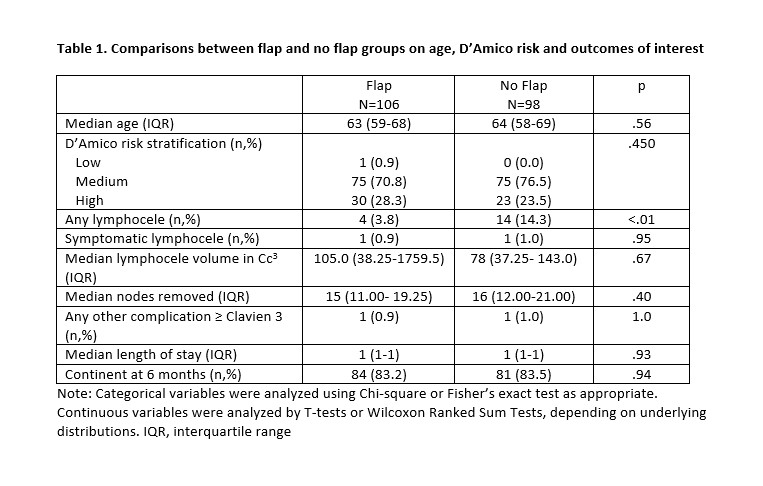The Effect of a Bladder Peritoneal Flap on Lymphocele Formation after Robotic Radical Prostatectomy
Joseph Wagner, MD, Ilene Staff, PhD, Tara McLaughlin, PhD, Joseph Tortora, MS, Kevin Pinto, BS, Akshay Gangakhedkar, BS.
Hartford Hospital, Hartford, CT, USA.
BACKGROUND: Numerous series suggest that utilizing a slightly varied bladder peritoneal flap fixation technique lowers the rate of lymphocele formation after radical prostatectomy yet randomized prospective studies are lacking. Here we report on the results of a randomized clinical trial evaluating the effect of this technique on lymphocele formation after robotic radical prostatectomy.
METHODS: Men (ages 18-89) undergoing robotic assisted radical prostatectomy with standard bilateral extended pelvic lymph node dissection (RARP/PLND) by a single surgeon were randomized 1:1 into two groups: one group underwent the creation of a bladder peritoneal advancement flap and the other underwent RARP/PLND as standard of care. Group assignment was revealed to the surgeon at the conclusion of the node dissection. All patients underwent an assessor-blinded pelvic ultrasound 3-12 months postoperatively to assess for lymphocele formation. Primary outcomes were rates of lymphocele formation and complications (Clavien ≥3). Length of stay (LOS), number lymph nodes removed, lymphocele volume, and continence at 6 months were secondary outcomes. An a priori power calculation was performed based on an estimate of 50% incidence of lymphoceles for the non-flap group and an assumption that the intervention will reduce the incidence of lymphoceles to 33%. Two interim analyses were conducted for safety and sample size using the O'Brien-Fleming method for alpha sharing and a desired sample of 134 per group was planned to achieve 80% power. Enrollment was stopped for efficacy after the second analysis. In this third interim analysis conducted for the purpose of dissemination, a significance level of .0184 was applied. The study was registered on ClinicalTrials.gov (NCT03567525).
RESULTS: No demographic differences were observed. The flap group had significantly fewer lymphoceles at follow-up relative to the no flap group (Table 1) but the groups did not differ on any other outcome.
CONCLUSIONS: Prior retrospective studies have suggested that various bladder peritoneal advancement flaps lead to a decreased rate of symptomatic lymphocele formation. This prospective randomized trial supports the implementation of this simple modification for RARP/PLND. 
Back to 2022 Abstracts


